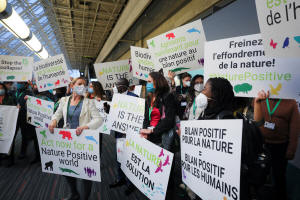|
Negotiators hope the two-week event delivers an agreement that
ensures there is more "nature" — animals, plants, and healthy
ecosystems — in 2030 than what exists now.
But disagreements over targets and the sheer amount of material
to go through over the next two weeks at COP15 remain concerns,
said Gavin Edwards, director of World Wildlife Fund
International.
"There are going to be some really late nights here to be able
to get the agreement we want," Edwards said on the sidelines of
the event, as campaigners chanted slogans.
"But we're talking about the future of life on Earth here."
An agreement could lead to protections of almost a third of the
world's land and oceans by 2030, more sustainable agricultural
systems, forestry and fisheries, he said.
"Governments have a once-in-a-decade opportunity to agree that
here."
Earlier in the day Canada's Prime Minister Justin Trudeau
announced up to C$800 million ($586 million) over seven years on
up to four indigenous-led conservation efforts, helping the
country preserve 30% of its land by 2030.
More than 1 million species, especially insects, are now
threatened with extinction, vanishing at a rate not seen in 10
million years. As much as 40% of Earth's land surfaces are
considered degraded, according to a 2022 U.N. Global Land
Outlook assessment.
($1 = 1.3651 Canadian dollars)
Read more:
Businesses want COP15 nature summit to deliver clarity
U.N. chief urges strong global nature deal to end 'orgy of
destruction'
(Reporting by Allison Lampert and Gloria Dickie in Montreal;
Editing by Lisa Shumaker)
[© 2022 Thomson Reuters. All rights
reserved.] Copyright 2022 Reuters. All rights reserved. This material may not be published,
broadcast, rewritten or redistributed.
Thompson Reuters is solely responsible for this content.

|
|




